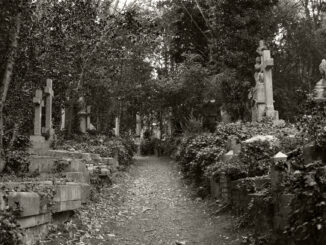
Before European settlers came to the North American continent, the Native peoples lived close to the natural world and were intimately acquainted with every animal that lived on the land. Everything from the lowly mouse to even more monstrous creatures such as the winged horror known as the thunderbird.
According to legends, the thunderbird was a gigantic bird with a wingspan large enough to block out the sun. The thunderbird was considered both a friend and dangerous adversary. These enormous birds would bring the precious rains for crops. However, they were also known to swoop out of the skies and carry off both livestock and children. These nightmarish creatures are oft considered to be nothing more than a legend by most. But, as with any legend, there may be some truth to their dreaded existence.
During the Pleistocene era, large predatory birds called teratorns ruled the skies of prehistoric North America. It’s believed they became extinct around 50,000 years ago. The largest of these birds, Teratornis Merriami, was over double the size of the California Condor. According to the fossil record, this formidable bird was over three feet long and a wingspan measuring 20 feet which made it a truly terrifying sight for prehistoric man to behold.
When considering the era teratorns in which existed, early Native Americans could not have had encounters with this feathered terror as they predate the earliest settlers in the Americas by twenty thousand years.
Looking at our skies, it is obvious that these birds have long since gone extinct. Nevertheless, here in Illinois, there have been several thunderbird sightings leading many to believe the skies over the Prairie State aren’t as safe as they should be.
In the 1600s, Illinois was a vast wilderness untouched by the European settlers who called the east coast home. In 1673, Jacques Marquette, a Jesuit priest and explorer, saw a bloodcurdling sight. While sailing down the Mississippi near Alton, he saw a ferocious beast carved into a limestone bluff. Marquette, described the beast as having a body the size of a cow with horns. Its vicious eyes burned with the fires of hell and had a bearded face. Marquette, asked if anyone knew what this painting was and the local tribes told him the monster was called Piasa. A vicious monster that had terrorized the native people of Illinois for centuries.
It would be easy to just dismiss the Piasa as nothing more than a fanciful creature. However, in 1836, professor John Russell heard the legend and wondered if there was anything to the stories. When he arrived in Illinois, Russell, hired a native guide and went out in search of the vicious Piasa.
While traveling down the Illinois River, Russell and his guide discovered a cave in the rock face. When they entered the cavern, they discovered hundreds of human and animal bones picked bare. Russell was convinced the cave was the lair of the Piasa and his guide demanded they leave at once. Looking out over the bones, John Russell, was all too happy to oblige.
Modern researchers believe the carving of the horrific Piasa was a representation of the dreaded thunderbird.

T-Shirts, Mugs and More!
We now have t-shirts, tarot decks, ESP cards, coffee mugs, face masks, and much more merchandise available for purchase. Every dollar spent helps fund Paranormal Study!
Quite possibly the most dramatic modern encounter with a thunderbird occurred in the small town of Lawndale, Illinois in the 1970s. In July of 1977, several people in Lawndale reported two large black birds circling the town overhead. The birds were described as jet black with a white ring encircling their necks. But it was the size of the birds that terrified the eyewitnesses. According to the eyewitnesses, the bird’s bodies were the size of a man with a wingspan that exceeded 20 feet. Residents of the town were so frightened they kept their pets indoors. The birds, however, had a much different prey in mind.
In the early evening hours of July 25, ten-year-old Marlon Lowe and his friends were playing tag in his yard when the unimaginable occurred. As the boys were playing, their attention was drawn skyward by a loud screeching noise. They watched in horror as a giant black bird swooped out of the sky and snatched up Marlon Lowe. The boy screamed and did his best to fight off the bird, but it was far too strong. When his mother heard his screams, she ran outside and hit the bird until it released her boy. Those who witnessed the attempted abduction said the bird carried Marlon thirty-five feet before flying off.
A few days after the attack, a nearby farmer, his wife and several friends spotted the two birds in McClean County. The farmer and his guests were watching radio-controlled planes when the birds flew up to the planes. They said the birds easily dwarfed the planes. The farmer reported the sightings to the sheriff who considered the man to be a reliable and sober witness.
The summer of 1977 turned out to be the summer of the thunderbird. John Huffer, a Native American man, saw the birds and managed to film them. While fishing, Huffer, sighted two large black birds sitting in a tree. When the birds took flight, Huffer grabbed his camera and filmed the them. Fearing the birds might attack, he sounded his bullhorn and scared them off. While Huffer’s film is certainly controversial, many consider it to be the proof the thunderbird escaped extinction.
Since 1977, reports of giant black birds over Illinois have dropped off drastically, however, people still claim to see the thunderbirds. Critics believe the overwhelming majority of reports are miscalculations of known birds and they may be right. However, the attack on Marlon Lowe, and numerous credible eyewitness accounts refute such dismissals. It’s likely early Native Americans did deal with these birds.
But according to mainstream science giant birds are long dead. If people aren’t seeing Thunderbirds, we have to ask the question – What could they be seeing?
If you found the content in this article to be of any value to your paranormal studies, please let us know in the comments below. Feel free to share this article with your friends as well because if you found it interesting, they might too.
Do You Want To Know More?
Our content creators also have podcasts that go much deeper into paranormal topics.
Tim Woolworth’s Walk in the Shadows, an episodic masterclass that consists of a deep dive into all things Fortean, paranormal and supernatural.
Rick Hale teams up with Stephen Lancaster in The Shadow Initiative where they explore various paranormal topics and discuss current paranormal news.
Please check these shows out and visit Paranormal Study social media to keep up to date on articles and all the things our authors are doing.




Be the first to comment